Behaviourism Management and Its Affect in Teaching
VerifiedAdded on 2023/06/13
|8
|2390
|130
AI Summary
This article discusses the use of behaviourism in aiding the development of children with special needs, particularly those with ADHD. It explores the different behavioural psychology theories that can be used, such as Pavlov’s Conditioning Theory and Skinner’s Radical Behaviour Theory, and emphasizes the importance of positive reinforcement in the teaching process. The article also highlights the role of the teacher in aiding the development of the children and the different situational factors affecting their psychological development.
Contribute Materials
Your contribution can guide someone’s learning journey. Share your
documents today.
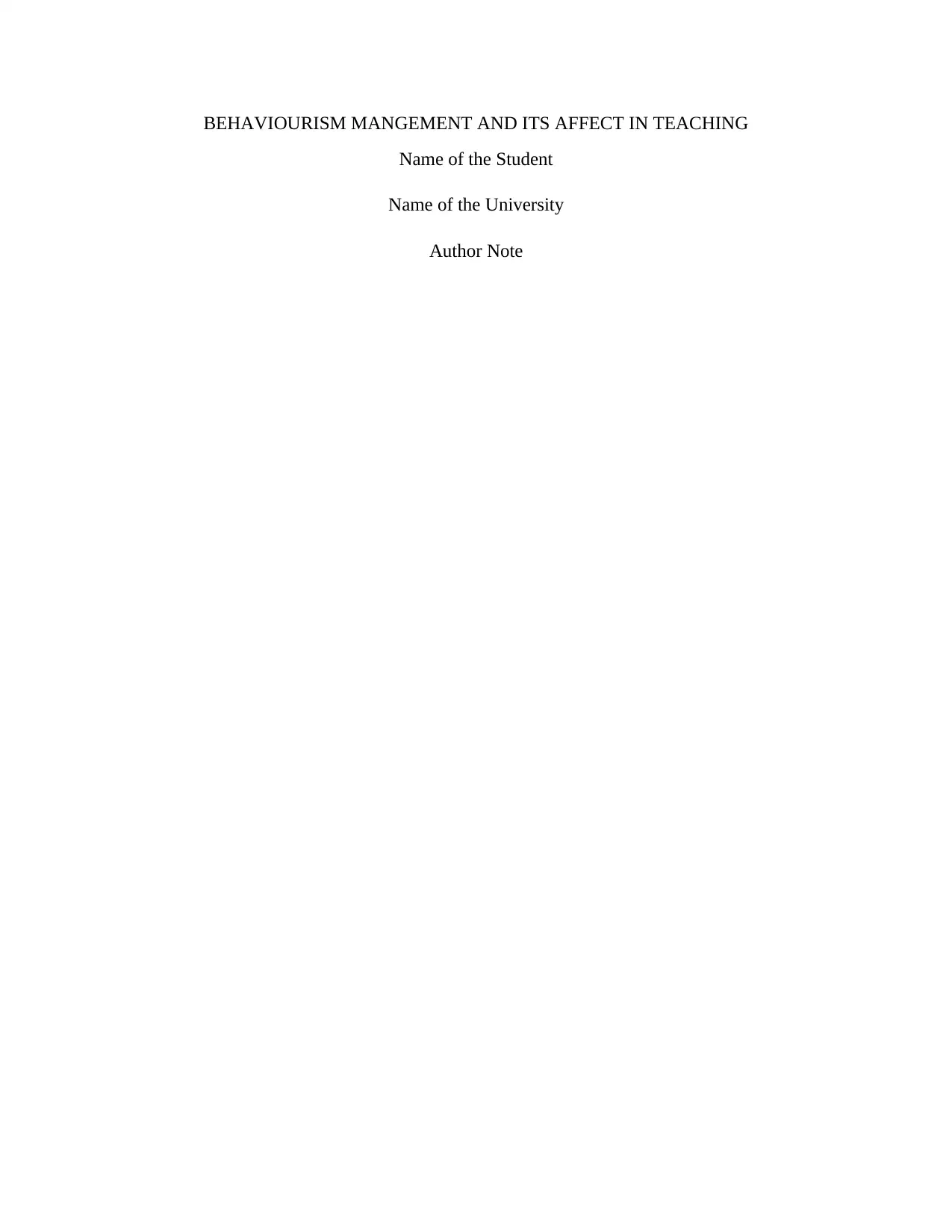
BEHAVIOURISM MANGEMENT AND ITS AFFECT IN TEACHING
Name of the Student
Name of the University
Author Note
Name of the Student
Name of the University
Author Note
Secure Best Marks with AI Grader
Need help grading? Try our AI Grader for instant feedback on your assignments.
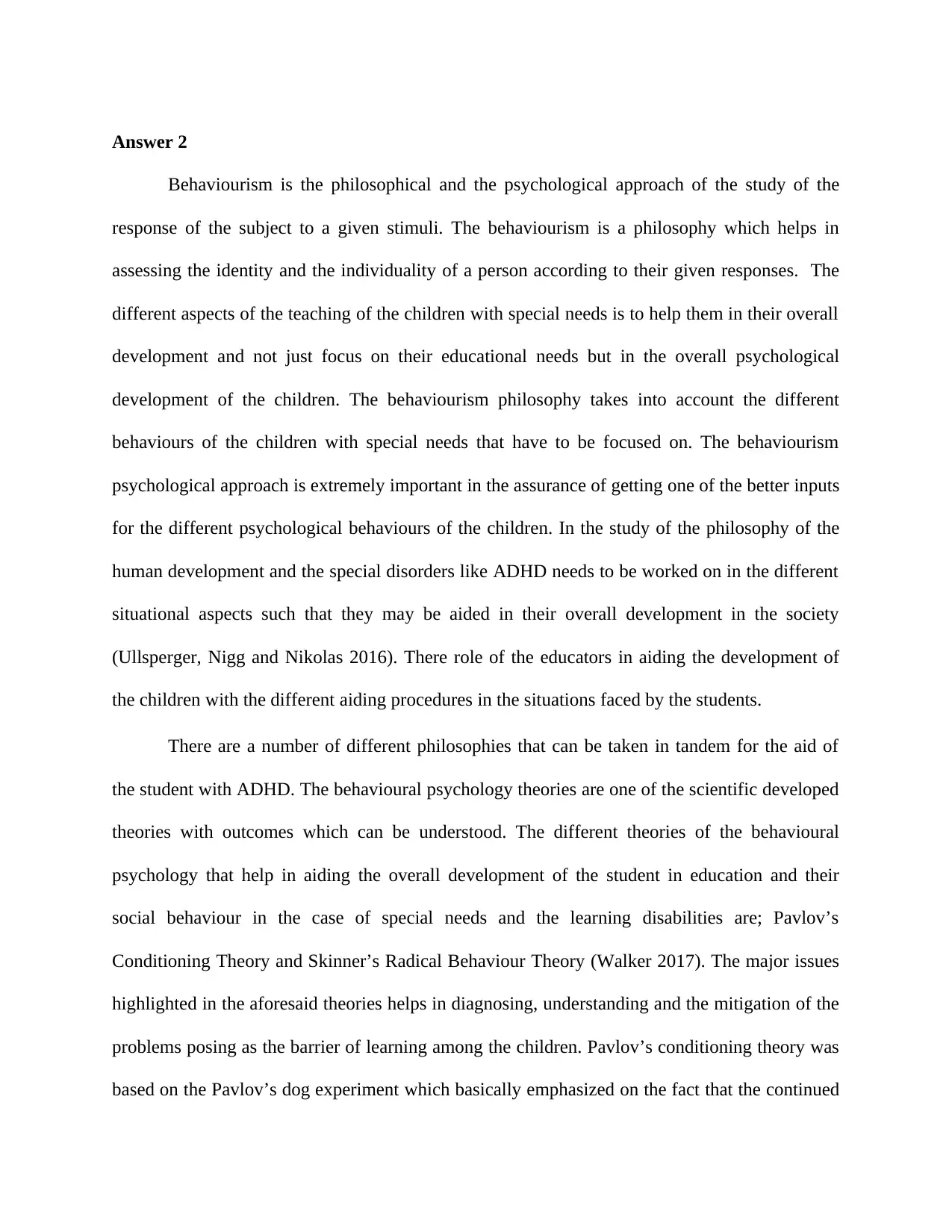
Answer 2
Behaviourism is the philosophical and the psychological approach of the study of the
response of the subject to a given stimuli. The behaviourism is a philosophy which helps in
assessing the identity and the individuality of a person according to their given responses. The
different aspects of the teaching of the children with special needs is to help them in their overall
development and not just focus on their educational needs but in the overall psychological
development of the children. The behaviourism philosophy takes into account the different
behaviours of the children with special needs that have to be focused on. The behaviourism
psychological approach is extremely important in the assurance of getting one of the better inputs
for the different psychological behaviours of the children. In the study of the philosophy of the
human development and the special disorders like ADHD needs to be worked on in the different
situational aspects such that they may be aided in their overall development in the society
(Ullsperger, Nigg and Nikolas 2016). There role of the educators in aiding the development of
the children with the different aiding procedures in the situations faced by the students.
There are a number of different philosophies that can be taken in tandem for the aid of
the student with ADHD. The behavioural psychology theories are one of the scientific developed
theories with outcomes which can be understood. The different theories of the behavioural
psychology that help in aiding the overall development of the student in education and their
social behaviour in the case of special needs and the learning disabilities are; Pavlov’s
Conditioning Theory and Skinner’s Radical Behaviour Theory (Walker 2017). The major issues
highlighted in the aforesaid theories helps in diagnosing, understanding and the mitigation of the
problems posing as the barrier of learning among the children. Pavlov’s conditioning theory was
based on the Pavlov’s dog experiment which basically emphasized on the fact that the continued
Behaviourism is the philosophical and the psychological approach of the study of the
response of the subject to a given stimuli. The behaviourism is a philosophy which helps in
assessing the identity and the individuality of a person according to their given responses. The
different aspects of the teaching of the children with special needs is to help them in their overall
development and not just focus on their educational needs but in the overall psychological
development of the children. The behaviourism philosophy takes into account the different
behaviours of the children with special needs that have to be focused on. The behaviourism
psychological approach is extremely important in the assurance of getting one of the better inputs
for the different psychological behaviours of the children. In the study of the philosophy of the
human development and the special disorders like ADHD needs to be worked on in the different
situational aspects such that they may be aided in their overall development in the society
(Ullsperger, Nigg and Nikolas 2016). There role of the educators in aiding the development of
the children with the different aiding procedures in the situations faced by the students.
There are a number of different philosophies that can be taken in tandem for the aid of
the student with ADHD. The behavioural psychology theories are one of the scientific developed
theories with outcomes which can be understood. The different theories of the behavioural
psychology that help in aiding the overall development of the student in education and their
social behaviour in the case of special needs and the learning disabilities are; Pavlov’s
Conditioning Theory and Skinner’s Radical Behaviour Theory (Walker 2017). The major issues
highlighted in the aforesaid theories helps in diagnosing, understanding and the mitigation of the
problems posing as the barrier of learning among the children. Pavlov’s conditioning theory was
based on the Pavlov’s dog experiment which basically emphasized on the fact that the continued
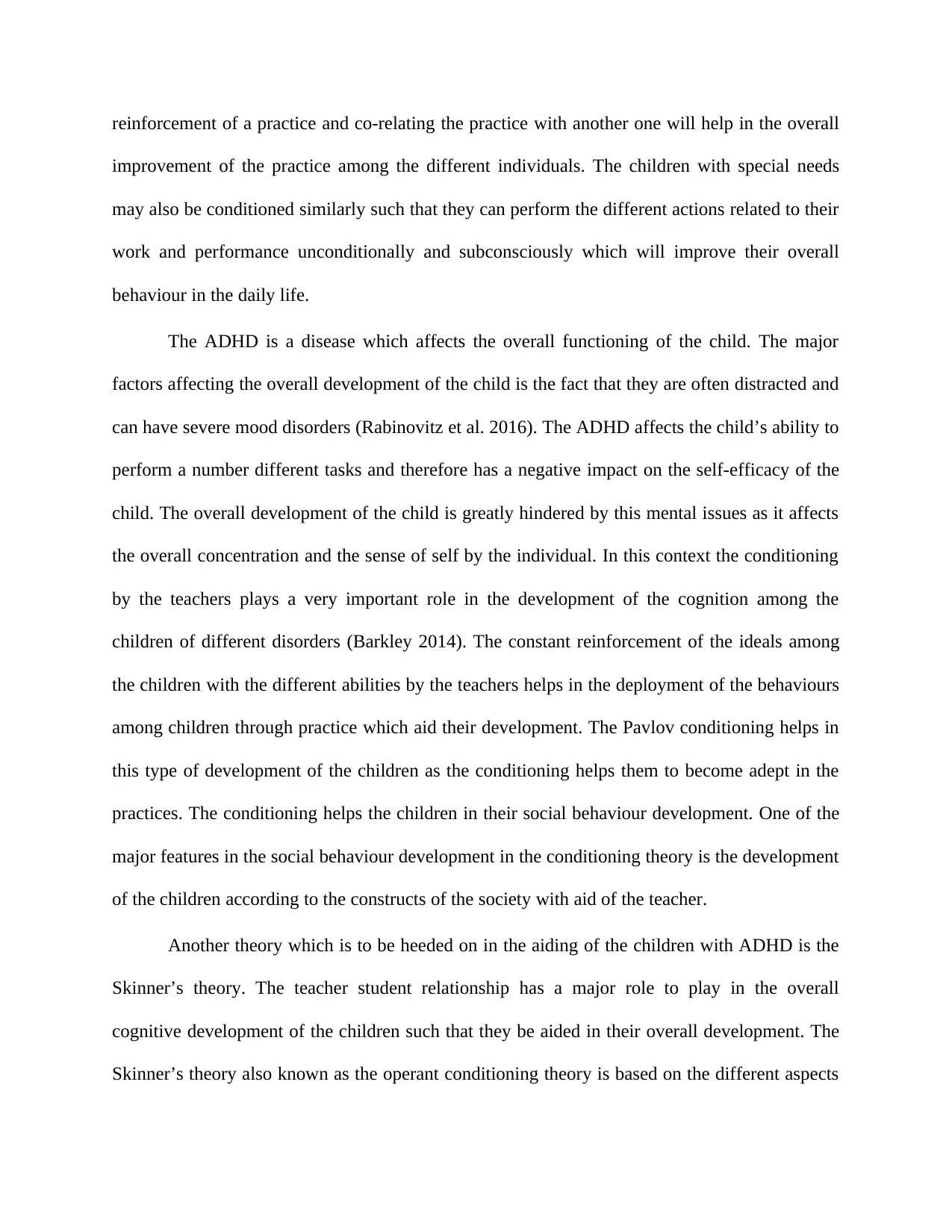
reinforcement of a practice and co-relating the practice with another one will help in the overall
improvement of the practice among the different individuals. The children with special needs
may also be conditioned similarly such that they can perform the different actions related to their
work and performance unconditionally and subconsciously which will improve their overall
behaviour in the daily life.
The ADHD is a disease which affects the overall functioning of the child. The major
factors affecting the overall development of the child is the fact that they are often distracted and
can have severe mood disorders (Rabinovitz et al. 2016). The ADHD affects the child’s ability to
perform a number different tasks and therefore has a negative impact on the self-efficacy of the
child. The overall development of the child is greatly hindered by this mental issues as it affects
the overall concentration and the sense of self by the individual. In this context the conditioning
by the teachers plays a very important role in the development of the cognition among the
children of different disorders (Barkley 2014). The constant reinforcement of the ideals among
the children with the different abilities by the teachers helps in the deployment of the behaviours
among children through practice which aid their development. The Pavlov conditioning helps in
this type of development of the children as the conditioning helps them to become adept in the
practices. The conditioning helps the children in their social behaviour development. One of the
major features in the social behaviour development in the conditioning theory is the development
of the children according to the constructs of the society with aid of the teacher.
Another theory which is to be heeded on in the aiding of the children with ADHD is the
Skinner’s theory. The teacher student relationship has a major role to play in the overall
cognitive development of the children such that they be aided in their overall development. The
Skinner’s theory also known as the operant conditioning theory is based on the different aspects
improvement of the practice among the different individuals. The children with special needs
may also be conditioned similarly such that they can perform the different actions related to their
work and performance unconditionally and subconsciously which will improve their overall
behaviour in the daily life.
The ADHD is a disease which affects the overall functioning of the child. The major
factors affecting the overall development of the child is the fact that they are often distracted and
can have severe mood disorders (Rabinovitz et al. 2016). The ADHD affects the child’s ability to
perform a number different tasks and therefore has a negative impact on the self-efficacy of the
child. The overall development of the child is greatly hindered by this mental issues as it affects
the overall concentration and the sense of self by the individual. In this context the conditioning
by the teachers plays a very important role in the development of the cognition among the
children of different disorders (Barkley 2014). The constant reinforcement of the ideals among
the children with the different abilities by the teachers helps in the deployment of the behaviours
among children through practice which aid their development. The Pavlov conditioning helps in
this type of development of the children as the conditioning helps them to become adept in the
practices. The conditioning helps the children in their social behaviour development. One of the
major features in the social behaviour development in the conditioning theory is the development
of the children according to the constructs of the society with aid of the teacher.
Another theory which is to be heeded on in the aiding of the children with ADHD is the
Skinner’s theory. The teacher student relationship has a major role to play in the overall
cognitive development of the children such that they be aided in their overall development. The
Skinner’s theory also known as the operant conditioning theory is based on the different aspects
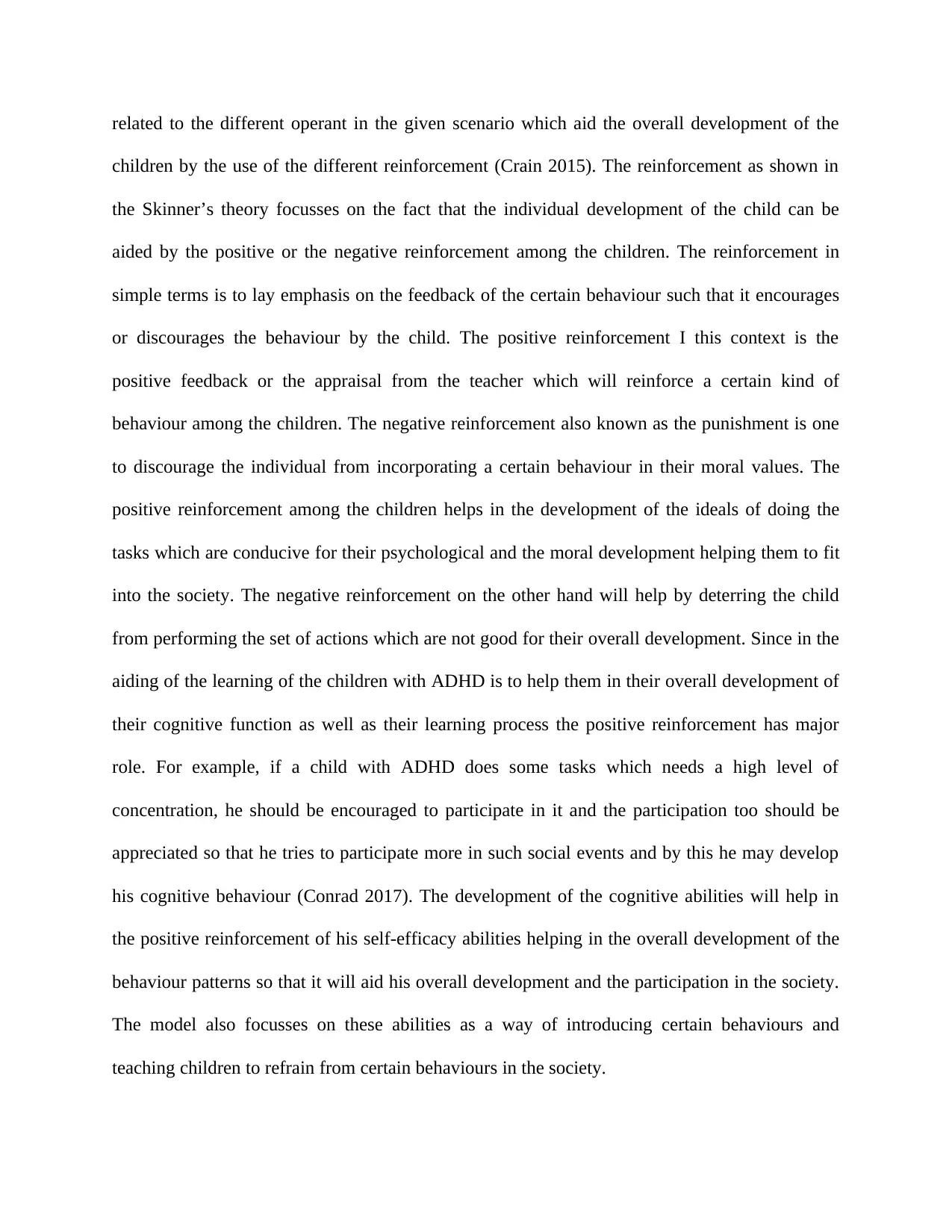
related to the different operant in the given scenario which aid the overall development of the
children by the use of the different reinforcement (Crain 2015). The reinforcement as shown in
the Skinner’s theory focusses on the fact that the individual development of the child can be
aided by the positive or the negative reinforcement among the children. The reinforcement in
simple terms is to lay emphasis on the feedback of the certain behaviour such that it encourages
or discourages the behaviour by the child. The positive reinforcement I this context is the
positive feedback or the appraisal from the teacher which will reinforce a certain kind of
behaviour among the children. The negative reinforcement also known as the punishment is one
to discourage the individual from incorporating a certain behaviour in their moral values. The
positive reinforcement among the children helps in the development of the ideals of doing the
tasks which are conducive for their psychological and the moral development helping them to fit
into the society. The negative reinforcement on the other hand will help by deterring the child
from performing the set of actions which are not good for their overall development. Since in the
aiding of the learning of the children with ADHD is to help them in their overall development of
their cognitive function as well as their learning process the positive reinforcement has major
role. For example, if a child with ADHD does some tasks which needs a high level of
concentration, he should be encouraged to participate in it and the participation too should be
appreciated so that he tries to participate more in such social events and by this he may develop
his cognitive behaviour (Conrad 2017). The development of the cognitive abilities will help in
the positive reinforcement of his self-efficacy abilities helping in the overall development of the
behaviour patterns so that it will aid his overall development and the participation in the society.
The model also focusses on these abilities as a way of introducing certain behaviours and
teaching children to refrain from certain behaviours in the society.
children by the use of the different reinforcement (Crain 2015). The reinforcement as shown in
the Skinner’s theory focusses on the fact that the individual development of the child can be
aided by the positive or the negative reinforcement among the children. The reinforcement in
simple terms is to lay emphasis on the feedback of the certain behaviour such that it encourages
or discourages the behaviour by the child. The positive reinforcement I this context is the
positive feedback or the appraisal from the teacher which will reinforce a certain kind of
behaviour among the children. The negative reinforcement also known as the punishment is one
to discourage the individual from incorporating a certain behaviour in their moral values. The
positive reinforcement among the children helps in the development of the ideals of doing the
tasks which are conducive for their psychological and the moral development helping them to fit
into the society. The negative reinforcement on the other hand will help by deterring the child
from performing the set of actions which are not good for their overall development. Since in the
aiding of the learning of the children with ADHD is to help them in their overall development of
their cognitive function as well as their learning process the positive reinforcement has major
role. For example, if a child with ADHD does some tasks which needs a high level of
concentration, he should be encouraged to participate in it and the participation too should be
appreciated so that he tries to participate more in such social events and by this he may develop
his cognitive behaviour (Conrad 2017). The development of the cognitive abilities will help in
the positive reinforcement of his self-efficacy abilities helping in the overall development of the
behaviour patterns so that it will aid his overall development and the participation in the society.
The model also focusses on these abilities as a way of introducing certain behaviours and
teaching children to refrain from certain behaviours in the society.
Secure Best Marks with AI Grader
Need help grading? Try our AI Grader for instant feedback on your assignments.
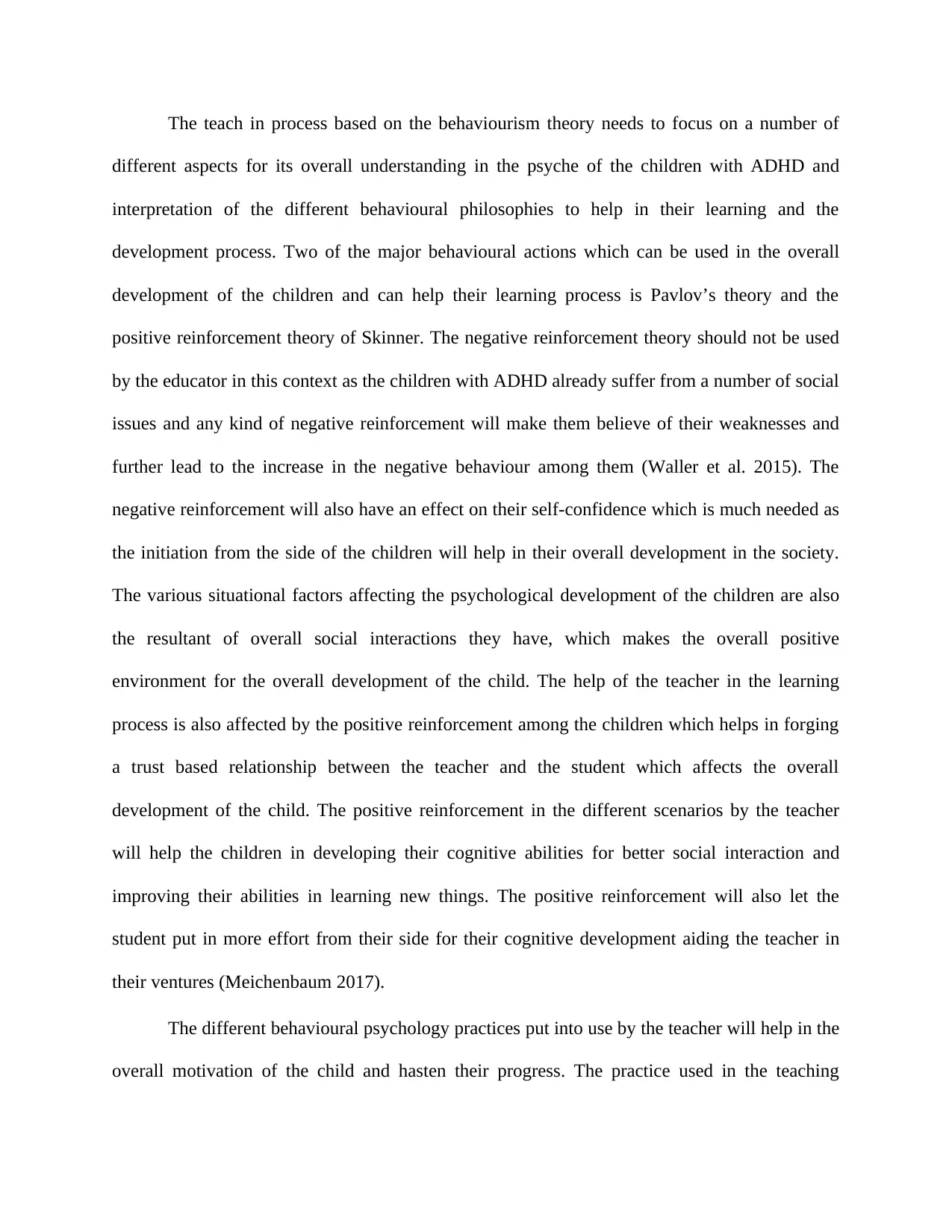
The teach in process based on the behaviourism theory needs to focus on a number of
different aspects for its overall understanding in the psyche of the children with ADHD and
interpretation of the different behavioural philosophies to help in their learning and the
development process. Two of the major behavioural actions which can be used in the overall
development of the children and can help their learning process is Pavlov’s theory and the
positive reinforcement theory of Skinner. The negative reinforcement theory should not be used
by the educator in this context as the children with ADHD already suffer from a number of social
issues and any kind of negative reinforcement will make them believe of their weaknesses and
further lead to the increase in the negative behaviour among them (Waller et al. 2015). The
negative reinforcement will also have an effect on their self-confidence which is much needed as
the initiation from the side of the children will help in their overall development in the society.
The various situational factors affecting the psychological development of the children are also
the resultant of overall social interactions they have, which makes the overall positive
environment for the overall development of the child. The help of the teacher in the learning
process is also affected by the positive reinforcement among the children which helps in forging
a trust based relationship between the teacher and the student which affects the overall
development of the child. The positive reinforcement in the different scenarios by the teacher
will help the children in developing their cognitive abilities for better social interaction and
improving their abilities in learning new things. The positive reinforcement will also let the
student put in more effort from their side for their cognitive development aiding the teacher in
their ventures (Meichenbaum 2017).
The different behavioural psychology practices put into use by the teacher will help in the
overall motivation of the child and hasten their progress. The practice used in the teaching
different aspects for its overall understanding in the psyche of the children with ADHD and
interpretation of the different behavioural philosophies to help in their learning and the
development process. Two of the major behavioural actions which can be used in the overall
development of the children and can help their learning process is Pavlov’s theory and the
positive reinforcement theory of Skinner. The negative reinforcement theory should not be used
by the educator in this context as the children with ADHD already suffer from a number of social
issues and any kind of negative reinforcement will make them believe of their weaknesses and
further lead to the increase in the negative behaviour among them (Waller et al. 2015). The
negative reinforcement will also have an effect on their self-confidence which is much needed as
the initiation from the side of the children will help in their overall development in the society.
The various situational factors affecting the psychological development of the children are also
the resultant of overall social interactions they have, which makes the overall positive
environment for the overall development of the child. The help of the teacher in the learning
process is also affected by the positive reinforcement among the children which helps in forging
a trust based relationship between the teacher and the student which affects the overall
development of the child. The positive reinforcement in the different scenarios by the teacher
will help the children in developing their cognitive abilities for better social interaction and
improving their abilities in learning new things. The positive reinforcement will also let the
student put in more effort from their side for their cognitive development aiding the teacher in
their ventures (Meichenbaum 2017).
The different behavioural psychology practices put into use by the teacher will help in the
overall motivation of the child and hasten their progress. The practice used in the teaching
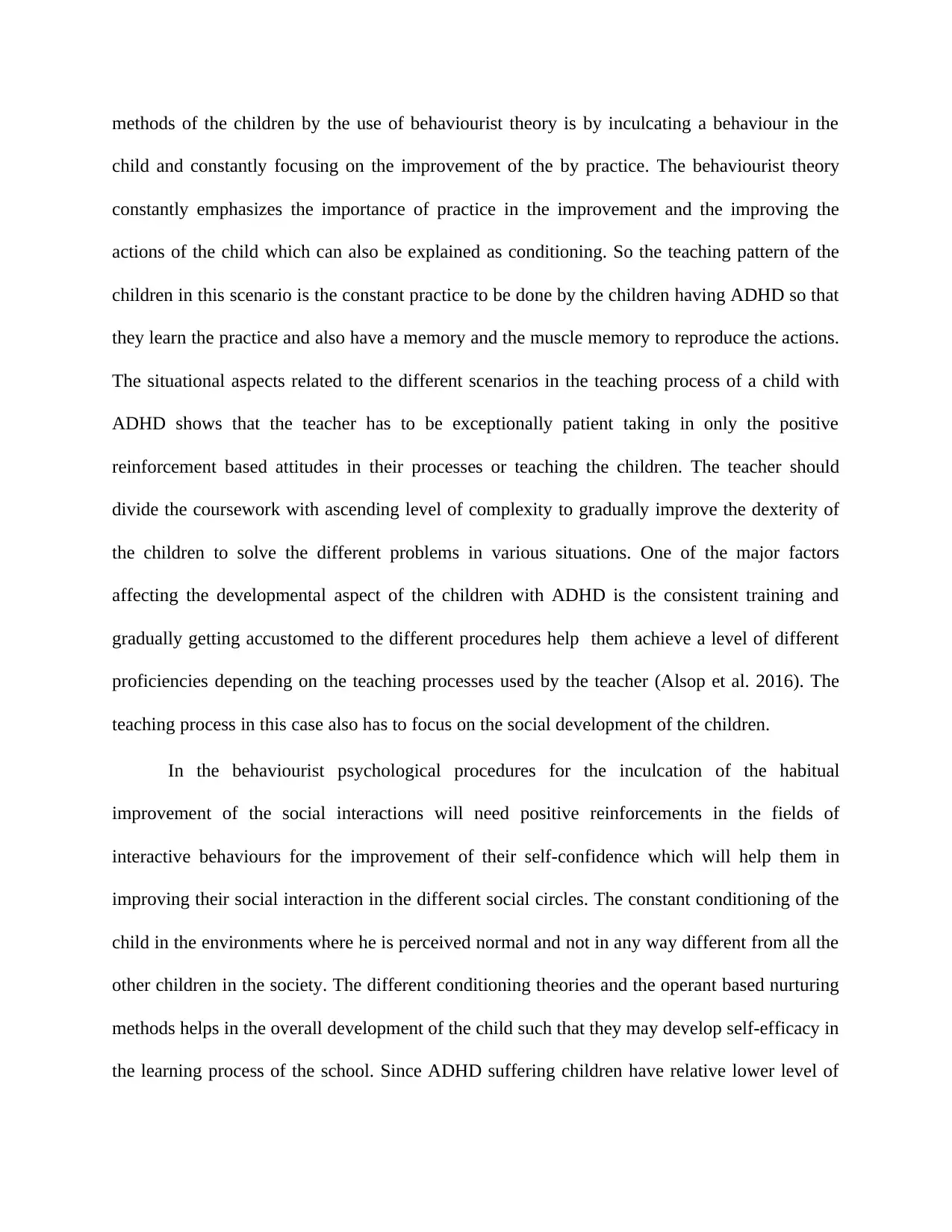
methods of the children by the use of behaviourist theory is by inculcating a behaviour in the
child and constantly focusing on the improvement of the by practice. The behaviourist theory
constantly emphasizes the importance of practice in the improvement and the improving the
actions of the child which can also be explained as conditioning. So the teaching pattern of the
children in this scenario is the constant practice to be done by the children having ADHD so that
they learn the practice and also have a memory and the muscle memory to reproduce the actions.
The situational aspects related to the different scenarios in the teaching process of a child with
ADHD shows that the teacher has to be exceptionally patient taking in only the positive
reinforcement based attitudes in their processes or teaching the children. The teacher should
divide the coursework with ascending level of complexity to gradually improve the dexterity of
the children to solve the different problems in various situations. One of the major factors
affecting the developmental aspect of the children with ADHD is the consistent training and
gradually getting accustomed to the different procedures help them achieve a level of different
proficiencies depending on the teaching processes used by the teacher (Alsop et al. 2016). The
teaching process in this case also has to focus on the social development of the children.
In the behaviourist psychological procedures for the inculcation of the habitual
improvement of the social interactions will need positive reinforcements in the fields of
interactive behaviours for the improvement of their self-confidence which will help them in
improving their social interaction in the different social circles. The constant conditioning of the
child in the environments where he is perceived normal and not in any way different from all the
other children in the society. The different conditioning theories and the operant based nurturing
methods helps in the overall development of the child such that they may develop self-efficacy in
the learning process of the school. Since ADHD suffering children have relative lower level of
child and constantly focusing on the improvement of the by practice. The behaviourist theory
constantly emphasizes the importance of practice in the improvement and the improving the
actions of the child which can also be explained as conditioning. So the teaching pattern of the
children in this scenario is the constant practice to be done by the children having ADHD so that
they learn the practice and also have a memory and the muscle memory to reproduce the actions.
The situational aspects related to the different scenarios in the teaching process of a child with
ADHD shows that the teacher has to be exceptionally patient taking in only the positive
reinforcement based attitudes in their processes or teaching the children. The teacher should
divide the coursework with ascending level of complexity to gradually improve the dexterity of
the children to solve the different problems in various situations. One of the major factors
affecting the developmental aspect of the children with ADHD is the consistent training and
gradually getting accustomed to the different procedures help them achieve a level of different
proficiencies depending on the teaching processes used by the teacher (Alsop et al. 2016). The
teaching process in this case also has to focus on the social development of the children.
In the behaviourist psychological procedures for the inculcation of the habitual
improvement of the social interactions will need positive reinforcements in the fields of
interactive behaviours for the improvement of their self-confidence which will help them in
improving their social interaction in the different social circles. The constant conditioning of the
child in the environments where he is perceived normal and not in any way different from all the
other children in the society. The different conditioning theories and the operant based nurturing
methods helps in the overall development of the child such that they may develop self-efficacy in
the learning process of the school. Since ADHD suffering children have relative lower level of
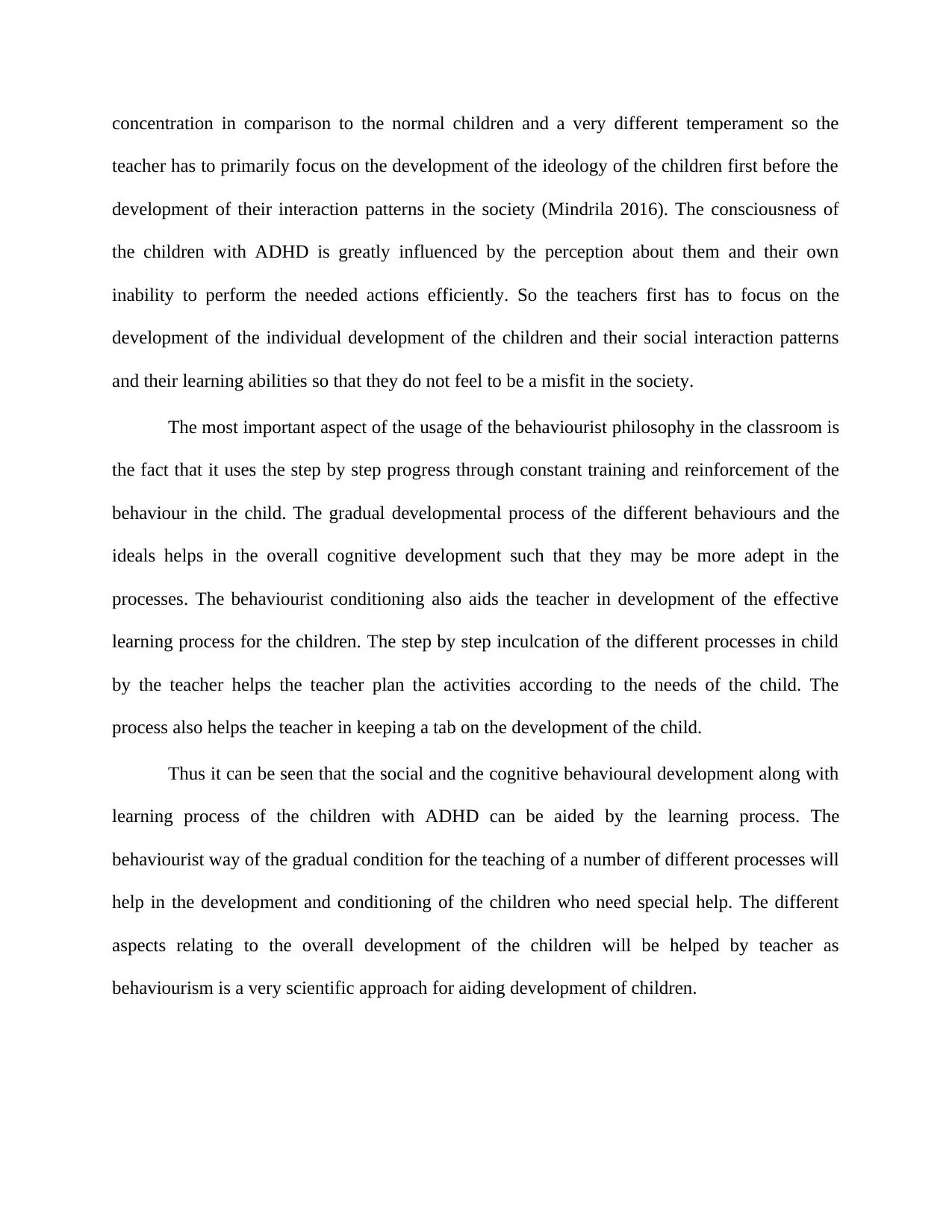
concentration in comparison to the normal children and a very different temperament so the
teacher has to primarily focus on the development of the ideology of the children first before the
development of their interaction patterns in the society (Mindrila 2016). The consciousness of
the children with ADHD is greatly influenced by the perception about them and their own
inability to perform the needed actions efficiently. So the teachers first has to focus on the
development of the individual development of the children and their social interaction patterns
and their learning abilities so that they do not feel to be a misfit in the society.
The most important aspect of the usage of the behaviourist philosophy in the classroom is
the fact that it uses the step by step progress through constant training and reinforcement of the
behaviour in the child. The gradual developmental process of the different behaviours and the
ideals helps in the overall cognitive development such that they may be more adept in the
processes. The behaviourist conditioning also aids the teacher in development of the effective
learning process for the children. The step by step inculcation of the different processes in child
by the teacher helps the teacher plan the activities according to the needs of the child. The
process also helps the teacher in keeping a tab on the development of the child.
Thus it can be seen that the social and the cognitive behavioural development along with
learning process of the children with ADHD can be aided by the learning process. The
behaviourist way of the gradual condition for the teaching of a number of different processes will
help in the development and conditioning of the children who need special help. The different
aspects relating to the overall development of the children will be helped by teacher as
behaviourism is a very scientific approach for aiding development of children.
teacher has to primarily focus on the development of the ideology of the children first before the
development of their interaction patterns in the society (Mindrila 2016). The consciousness of
the children with ADHD is greatly influenced by the perception about them and their own
inability to perform the needed actions efficiently. So the teachers first has to focus on the
development of the individual development of the children and their social interaction patterns
and their learning abilities so that they do not feel to be a misfit in the society.
The most important aspect of the usage of the behaviourist philosophy in the classroom is
the fact that it uses the step by step progress through constant training and reinforcement of the
behaviour in the child. The gradual developmental process of the different behaviours and the
ideals helps in the overall cognitive development such that they may be more adept in the
processes. The behaviourist conditioning also aids the teacher in development of the effective
learning process for the children. The step by step inculcation of the different processes in child
by the teacher helps the teacher plan the activities according to the needs of the child. The
process also helps the teacher in keeping a tab on the development of the child.
Thus it can be seen that the social and the cognitive behavioural development along with
learning process of the children with ADHD can be aided by the learning process. The
behaviourist way of the gradual condition for the teaching of a number of different processes will
help in the development and conditioning of the children who need special help. The different
aspects relating to the overall development of the children will be helped by teacher as
behaviourism is a very scientific approach for aiding development of children.
Paraphrase This Document
Need a fresh take? Get an instant paraphrase of this document with our AI Paraphraser
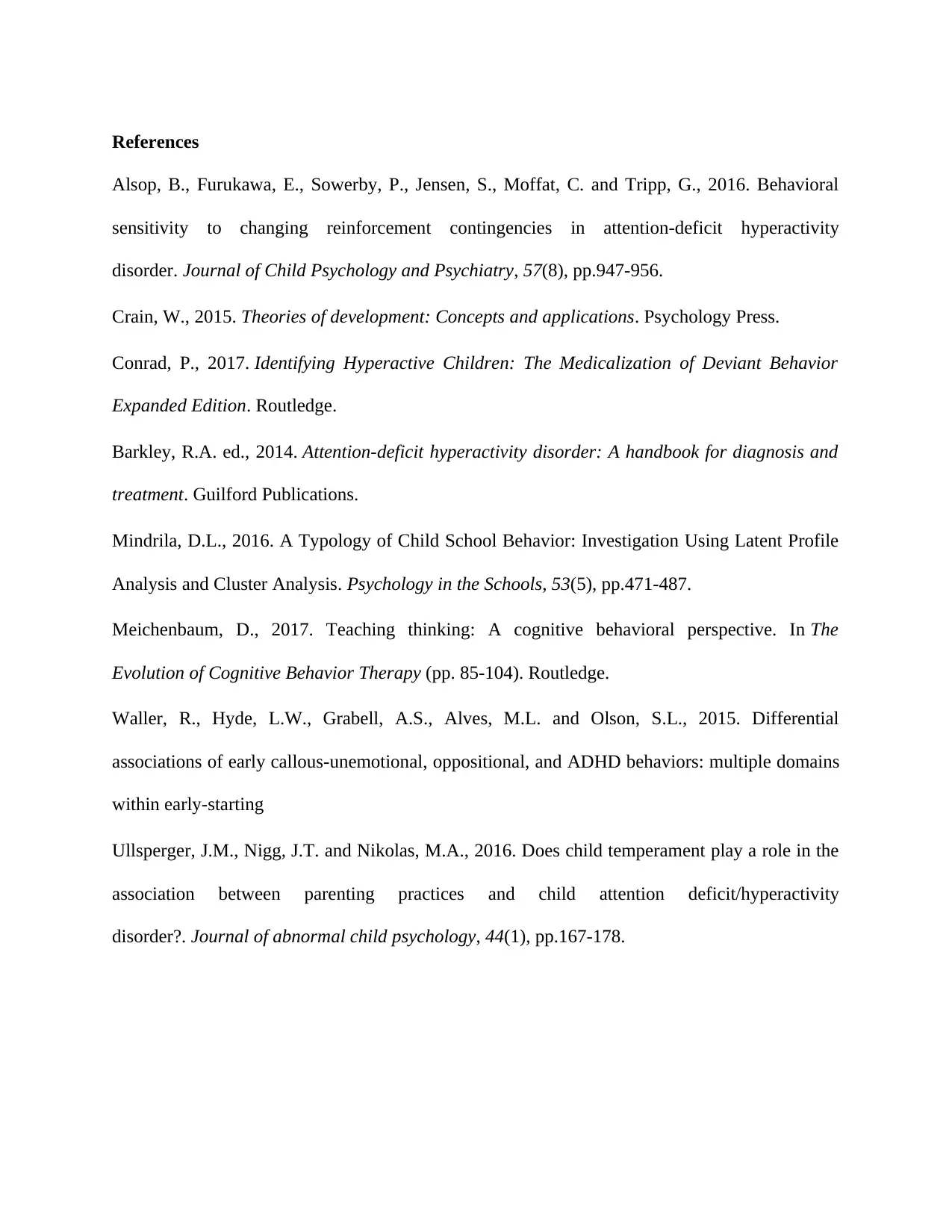
References
Alsop, B., Furukawa, E., Sowerby, P., Jensen, S., Moffat, C. and Tripp, G., 2016. Behavioral
sensitivity to changing reinforcement contingencies in attention‐deficit hyperactivity
disorder. Journal of Child Psychology and Psychiatry, 57(8), pp.947-956.
Crain, W., 2015. Theories of development: Concepts and applications. Psychology Press.
Conrad, P., 2017. Identifying Hyperactive Children: The Medicalization of Deviant Behavior
Expanded Edition. Routledge.
Barkley, R.A. ed., 2014. Attention-deficit hyperactivity disorder: A handbook for diagnosis and
treatment. Guilford Publications.
Mindrila, D.L., 2016. A Typology of Child School Behavior: Investigation Using Latent Profile
Analysis and Cluster Analysis. Psychology in the Schools, 53(5), pp.471-487.
Meichenbaum, D., 2017. Teaching thinking: A cognitive behavioral perspective. In The
Evolution of Cognitive Behavior Therapy (pp. 85-104). Routledge.
Waller, R., Hyde, L.W., Grabell, A.S., Alves, M.L. and Olson, S.L., 2015. Differential
associations of early callous‐unemotional, oppositional, and ADHD behaviors: multiple domains
within early‐starting
Ullsperger, J.M., Nigg, J.T. and Nikolas, M.A., 2016. Does child temperament play a role in the
association between parenting practices and child attention deficit/hyperactivity
disorder?. Journal of abnormal child psychology, 44(1), pp.167-178.
Alsop, B., Furukawa, E., Sowerby, P., Jensen, S., Moffat, C. and Tripp, G., 2016. Behavioral
sensitivity to changing reinforcement contingencies in attention‐deficit hyperactivity
disorder. Journal of Child Psychology and Psychiatry, 57(8), pp.947-956.
Crain, W., 2015. Theories of development: Concepts and applications. Psychology Press.
Conrad, P., 2017. Identifying Hyperactive Children: The Medicalization of Deviant Behavior
Expanded Edition. Routledge.
Barkley, R.A. ed., 2014. Attention-deficit hyperactivity disorder: A handbook for diagnosis and
treatment. Guilford Publications.
Mindrila, D.L., 2016. A Typology of Child School Behavior: Investigation Using Latent Profile
Analysis and Cluster Analysis. Psychology in the Schools, 53(5), pp.471-487.
Meichenbaum, D., 2017. Teaching thinking: A cognitive behavioral perspective. In The
Evolution of Cognitive Behavior Therapy (pp. 85-104). Routledge.
Waller, R., Hyde, L.W., Grabell, A.S., Alves, M.L. and Olson, S.L., 2015. Differential
associations of early callous‐unemotional, oppositional, and ADHD behaviors: multiple domains
within early‐starting
Ullsperger, J.M., Nigg, J.T. and Nikolas, M.A., 2016. Does child temperament play a role in the
association between parenting practices and child attention deficit/hyperactivity
disorder?. Journal of abnormal child psychology, 44(1), pp.167-178.
1 out of 8
Your All-in-One AI-Powered Toolkit for Academic Success.
+13062052269
info@desklib.com
Available 24*7 on WhatsApp / Email
![[object Object]](/_next/static/media/star-bottom.7253800d.svg)
Unlock your academic potential
© 2024 | Zucol Services PVT LTD | All rights reserved.




